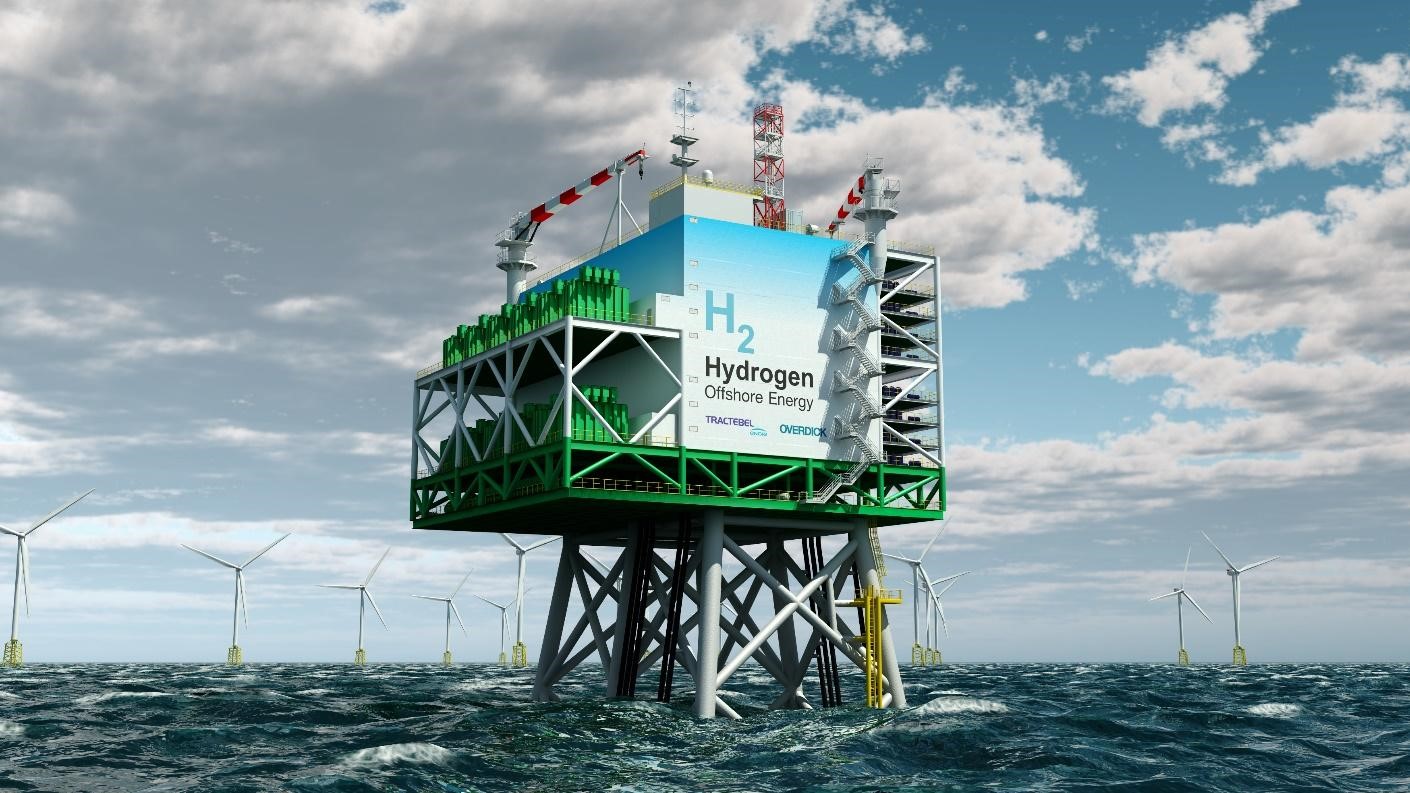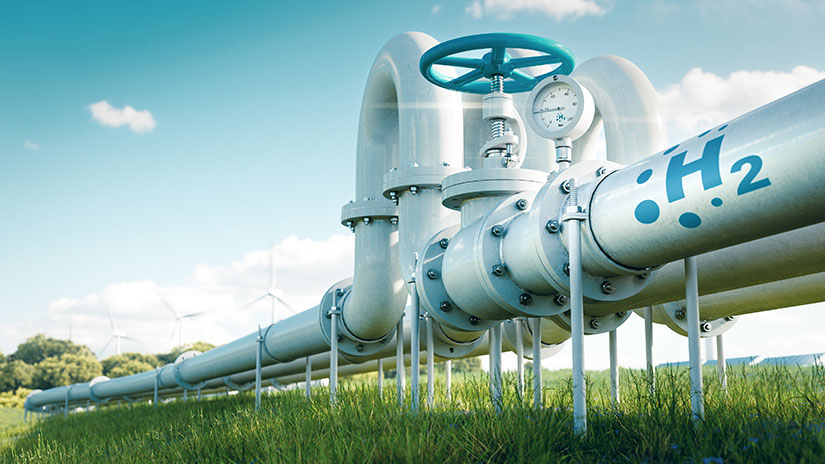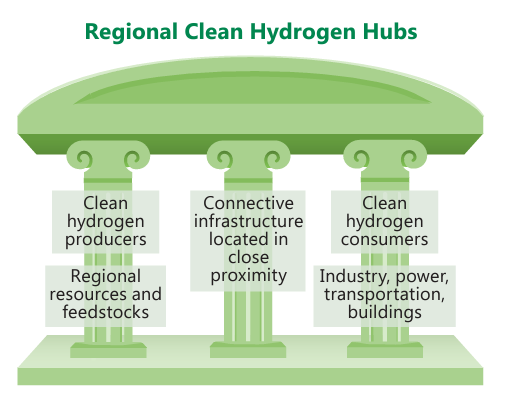There are a plethora of renewable energy sources, including solar, wind, nuclear, geothermal, or the newer green hydrogen, which utilizes and stores the other sources as usable fuel. To produce and utilize more green hydrogen, China, and the United States have laid out separate strategies that are encompassed by their larger goals for a sustainable future.
Why is Green Hydrogen Important
Hydrogen production can be separated into grey, blue, and green hydrogen based on the raw inputs and source of power to produce hydrogen. Both grey and blue hydrogen are produced using fossil fuels such as natural gas by a process called steam reforming, a popular option in the U.S. The process releases carbon dioxide as a byproduct that must be stored underground or released into the atmosphere.
Meanwhile, Green Hydrogen is made by separating hydrogen and oxygen molecules from water while using renewable energy resources such as wind, solar, or nuclear power. This is achieved by electrolysis, using electricity to shock hydrogen and oxygen atoms apart.
The future of green hydrogen is bright and could revolutionize how power is generated worldwide pushing us closer to a more sustainable future. The key differentiator between green hydrogen and other renewable energy resources is its ability to be transported by mediums similar to gas and oil, such as pipelines and fuel tankers. This allows areas rich in renewable energy to help supply other areas that aren’t as developed or lack the right climate to produce solar or wind energy.

However, green hydrogen still faces many challenges to mass adoption, such as transportation, and local buy-in, and teams of companies, researchers, universities, and governments worldwide are planning to overcome these barriers.
Once a new transportation infrastructure is established, green hydrogen will revolutionize how we produce renewable energy. Hydrogen could replace some fossil fuel generation, and new hydrogen fuel cells could power machinery and ships without the need for high-carbon-producing fuels. Through these improvements, green hydrogen will help accelerate a global transition to renewable energy.
China’s Strategy
China’s State Planner for hydrogen is targeting to produce 100,000 to 200,000 metric tons of green hydrogen by 2025. To achieve this, the state is investing heavily in new infrastructure and its state-owned enterprises, such as Sinopec, one of the country's largest oil companies.
After successful pipeline tests, China’s Sinopec announced that it would build a west-to-east green hydrogen pipeline from Inner Mongolia to eastern cities such as Beijing. Sinopec expects to expand this pipeline to take advantage of new hydrogen production sources.

Sinopec has also made other strides in pushing green hydrogen forward by opening a new production facility in Xinjiang that will start to replace grey hydrogen produced at its Tahe plant.
A key difference between China and the U.S.’s strategy is where they draw the base input of water from. The U.S. with its bountiful natural resources can draw hydrogen from natural gas or freshwater. However, China does not have access to those same resources. Therefore, they aim to draw hydrogen from seawater through electrolysis.
However, creating hydrogen from seawater has its challenges. Seawater’s composition includes chloride gas, which has a corrosive effect on the electrodes used for electrolysis and contains many micro particles that can decrease the purity of the hydrogen. Many green hydrogen plants are forced to desalinate seawater before producing hydrogen, an energy-intensive process that doubles the cost per kilogram of hydrogen. The process would make green hydrogen production a net loss for the producer, which researchers are attempting to resolve by coating the electrolysis equipment with a new membrane which could protect the machinery from the corrosive gas.
The team of researchers from the Dongfeng Electric Corporation and Nanjing University successfully converted seawater to hydrogen using their new membrane and wind power. The membrane can produce 99.9% pure hydrogen and increase the lifespan of the equipment used, making green hydrogen from seawater a more realistic option for energy production.
The U.S.’s Strategy
This June, The U.S. Department of Energy (DOE) released a National Strategy and Roadmap for Green Hydrogen adoption. Their goals encompass three key strategies: Strategy 1 - Target Strategic, High-Impact Uses of Clean Hydrogen; Strategy 2 - Reduce the Cost of Clean Energy; and finally, Strategy 3 - Focus on Regional Networks.
Instead of bringing hydrogen directly to the consumer market, the DOE wants Federal agencies to focus on Clean Hydrogen to address difficult-to-decarbonize segments of the economy. Strategy 1 incorporates three sectors: industrial applications, transportation, and power generation. Industrial applications include the chemical, industrial heat, and steelmaking industries. Transportation will target aviation, trains, and maritime transport mentioned above. Finally, power generation will target electricity generation, storage, and backup for areas that don’t have access to renewables.
Strategy 2 will focus on reducing the cost of a kilogram of hydrogen to be competitive against fossil fuels, such as natural gas. Over the next decade, the federal government will further encourage this by adding more supply to the market and reducing inefficiencies in the production of hydrogen. They are targeting a production cost of $1 per kilogram of hydrogen by 2031. Combined with a targeted cost of delivery and dispensing of $2 per kilogram, the cost of hydrogen will be at parity with the current costs of fossil fuels.
Strategy 3 will focus on the importance of regional networks in producing affordable clean hydrogen. According to the DOE “Regional networks will enable large-scale clean hydrogen production close to hydrogen users, enabling the development and sharing of a critical mass of infrastructure.” This is an evolution of the current electricity generation infrastructure in the U.S. that relies on regional or state utilities to provide the critical mass of infrastructure for power generation.
Regional clean hydrogen hubs will locate large-scale clean hydrogen production near end users, jump-start infrastructure development economic benefits, create well-paid jobs and tax revenue for regional economies, and establish a network of hydrogen producers and consumers.

The U.S. has been criticized for the large proportion of its hydrogen production that comes from blue and grey sources, which still release carbon into the atmosphere. These critics state that hydrogen is just another avenue for oil companies to continue releasing carbon instead of being a clean energy source. The U.S. will need to address these issues before they can confidently say that clean hydrogen is the way to a sustainable future.
How This Mirrors U.S.-China Relations
Both Beijing and Washington’s strategies seek to increase the adoption of green hydrogen in electricity generation and substitution of fossil fuels, and even have similar roadmaps to get there. However, there is currently extremely little collaboration between the two countries or any of their businesses on this matter, which mirrors many of the other relationships between the two countries, such as collaboration on high-tech or climate change.
Though we’ve seen an increase in high-level dialogues between China and the U.S. over the summer, since former Speaker of the House Nancy Pelosi visited Taiwan last year, China has continued to limit cooperation with the U.S. on numerous fronts, including climate change and renewable energy.
For the world to effectively combat climate change, these two superpowers must collaborate on this shared goal and avoid weaponizing it over temporary political strife.
